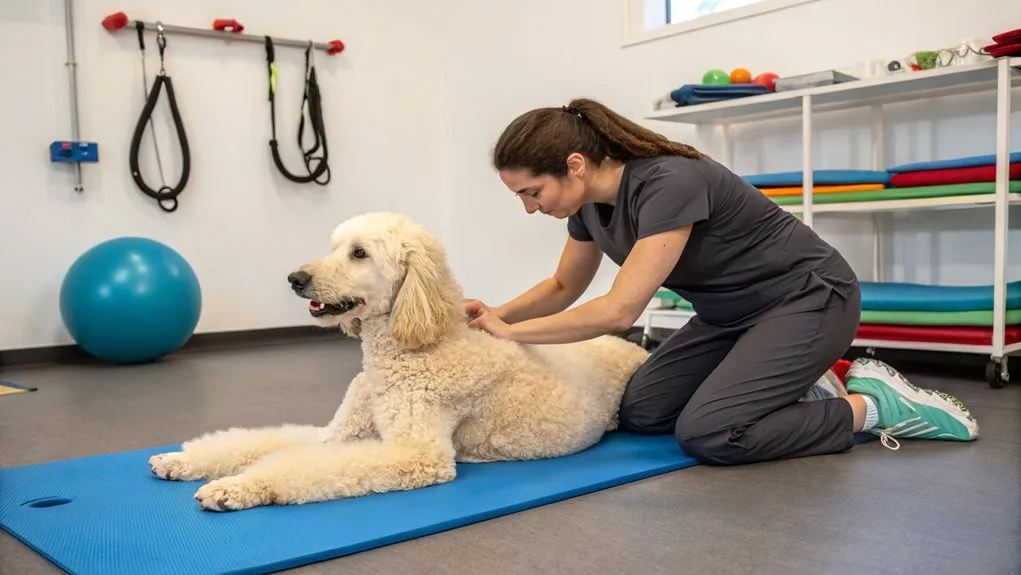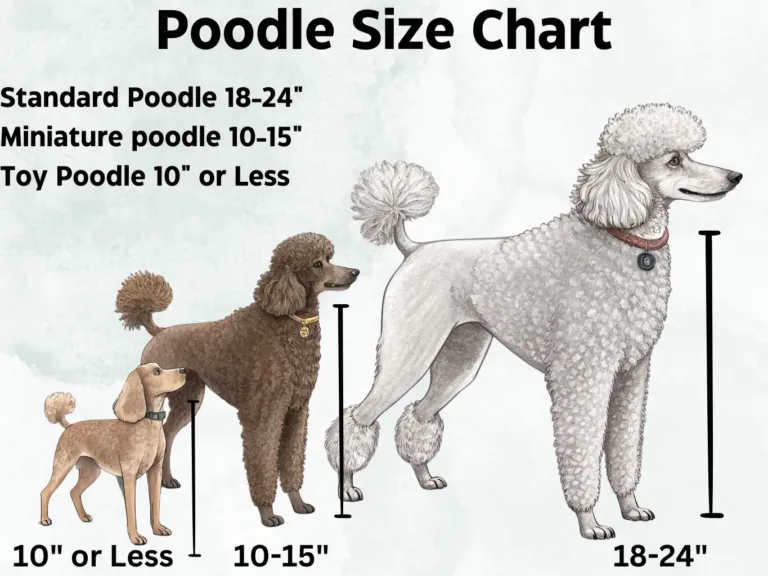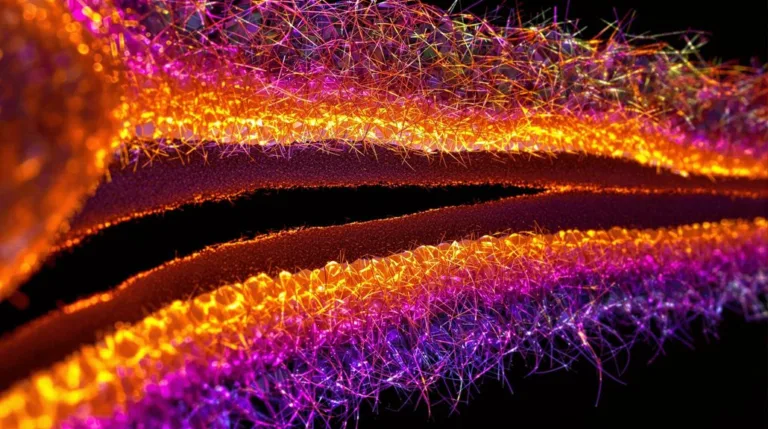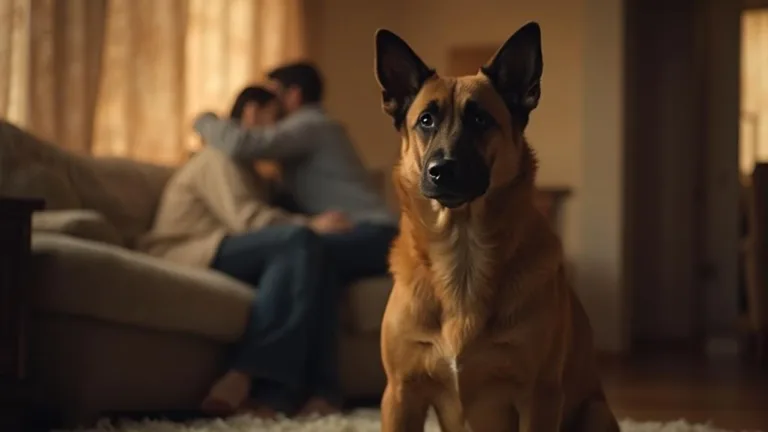Recognizing and Managing Hip Dysplasia in Poodles

Hip dysplasia in Poodles is a hereditary condition where the hip joint doesn’t develop properly, causing pain and mobility issues. Common signs include difficulty climbing stairs, reluctance to exercise, and a “bunny-hopping” gait when running. Standard Poodles are particularly at risk due to their size.
Early detection through veterinary screening and proper management can help affected dogs live comfortable lives. Treatment options range from lifestyle modifications like weight management and gentle exercise to surgical interventions in severe cases.
Physical therapy, especially swimming, can provide relief and maintain mobility. Understanding the full scope of care options will help you create the best plan for your Poodle’s well-being.
Key Takeaways
- Watch for typical symptoms like reluctance to climb stairs, bunny-hopping gait, and decreased activity levels in your Poodle.
- Maintain healthy weight through proper diet and portion control to reduce stress on hip joints.
- Create a safe environment with non-slip mats, cushioned beds, and elevated food bowls to improve comfort.
- Implement low-impact exercises like swimming and gentle walks on soft surfaces instead of high-intensity activities.
- Consult veterinarians for proper diagnosis through physical examination, x-rays, and development of appropriate treatment plans.
Understanding Hip Dysplasia in Poodles

Hip dysplasia frequently affects Poodles, particularly Standard Poodles, as a hereditary condition that impacts the development and function of their hip joints. This condition occurs when the ball and socket of the hip joint don’t fit together properly, leading to discomfort and mobility issues for these elegant dogs.
Due to genetic predisposition, some Poodles are more likely to develop this condition than others. Being among the larger breeds, Standard Poodles weighing between 45-70 pounds face an increased risk of developing hip dysplasia.
While breed standards emphasize the importance of proper structure and movement in Poodles, hip dysplasia can affect even well-bred dogs. The condition typically becomes noticeable as puppies grow, though some dogs may not show symptoms until later in life.
Signs include difficulty rising from a lying position, reluctance to jump or climb stairs, and a distinctive “bunny hop” gait when running. Think of it like a door hinge that’s slightly off – it still works, but not as smoothly as it should!
Understanding hip dysplasia is vital for Poodle owners because early detection can make a significant difference in managing the condition. Regular veterinary check-ups and x-rays can help identify problems before they become severe, leading to better outcomes for affected dogs.
Standard Poodles, with their 10 to 14 year average lifespan, may experience more severe symptoms of hip dysplasia as they age due to their larger size and weight.
Common Signs and Symptoms
The signs and symptoms of canine hip dysplasia in Poodles typically manifest in several distinct ways, ranging from subtle behavioral changes to obvious physical limitations. Owners may first notice their Poodle becoming reluctant to climb stairs or jump onto furniture – activities they once enjoyed without hesitation.
Pain behaviors like whimpering during movement or when the hip area is touched are common indicators.
As the condition progresses, mobility issues become more apparent. Affected Poodles often display a characteristic “bunny-hopping” gait when running, using both back legs together instead of the normal alternating pattern.
They might show difficulty getting up after rest periods or struggle to maintain balance while walking. The breed’s muscular build normally provides excellent strength and endurance, making these mobility challenges particularly noticeable.
Some Poodles may also develop a noticeable swaying of their back end when walking.
Other telling signs include decreased activity levels, muscle loss in the thigh area, and an unwillingness to play or exercise for extended periods. Owners might notice their Poodle lying down more frequently during walks or showing signs of stiffness, especially after physical activity or in cold weather.
Creating a calm daily routine with predictable exercise schedules can help manage symptoms and reduce stress on affected joints.
Risk Factors and Prevention

Several key factors contribute to the development of hip dysplasia in Poodles, with genetics playing a primary role in determining risk levels. Responsible breeders use genetic testing to screen potential breeding pairs, substantially reducing the likelihood of passing this condition to puppies.
Additionally, nutritional factors during a Poodle’s growth phase can impact hip development, making proper diet essential for prevention.
Environmental and lifestyle choices also influence hip dysplasia risk. Here are three critical prevention strategies that every Poodle owner should consider:
- Maintain appropriate weight through portion control and regular exercise to reduce stress on hip joints
- Provide proper nutrition with balanced calcium and phosphorus levels, especially during puppyhood
- Choose suitable exercise activities that avoid high-impact movements during developmental stages
Early intervention and awareness of these risk factors can make a substantial difference in managing hip dysplasia. While we can’t control genetic predisposition, we can focus on preventive measures that support healthy joint development.
Working closely with veterinarians to monitor growth patterns and making informed lifestyle choices helps create the best possible outcomes for our Poodle companions. High energy levels in Poodles make it especially important to balance exercise needs with joint health concerns.
Standard Poodles are particularly vulnerable during their extended growth period of 12 to 15 months when their joints are still developing.
Diagnosis and Testing Methods
Accurate diagnosis of hip dysplasia in Poodles requires a thorough medical evaluation, typically beginning with a physical examination and progressing to various imaging techniques.
During the initial exam, veterinarians observe the dog’s gait and manipulate the hip joints to check for pain, reduced range of motion, or unusual sounds.
X-rays remain the gold standard for diagnosis, providing clear images of the hip joint structure and any abnormalities. These radiographs help veterinarians grade the severity of the condition using standardized scoring systems.
More advanced imaging techniques, such as CT scans or MRI, may be used in complex cases to provide detailed 3D views of the joint.
Recent advances in veterinary medicine have introduced genetic testing to identify specific genetic markers associated with hip dysplasia. While these tests can’t diagnose the condition directly, they help breeders make informed decisions about breeding pairs.
Blood tests may also be conducted to rule out other conditions and assess inflammation levels. The combination of physical examination, imaging techniques, and genetic screening provides an exhaustive approach to diagnosis, allowing veterinarians to develop targeted treatment plans for affected Poodles.
Treatment Options and Therapies

Treatment approaches for canine hip dysplasia range from conservative management to surgical intervention, depending on the severity of the condition and the age of the Poodle. When caught early, many dogs respond well to non-surgical treatments that focus on managing pain and maintaining joint health.
These methods often include weight management, controlled exercise, and medications to reduce inflammation.
For more severe cases, surgical interventions may be necessary to improve the dog’s quality of life. These procedures can reshape the joint or even completely replace it, helping your Poodle move more comfortably.
Rehabilitation techniques play a vital role in both surgical and non-surgical treatment plans.
- Conservative Management: Physical therapy, joint supplements, and weight control
- Pain Management: Anti-inflammatory medications, acupuncture, and therapeutic massage
- Surgical Options: Total hip replacement, femoral head ostectomy, and triple pelvic osteotomy
After any treatment, following your veterinarian’s rehabilitation plan is essential for the best possible outcome. Many Poodles return to an active lifestyle with proper care and patience.
Living With an Affected Poodle
Daily life with a Poodle affected by hip dysplasia requires thoughtful adjustments to guarantee their comfort and well-being. Creating a consistent Daily Routine helps your furry friend navigate their condition while maintaining a happy lifestyle.
Simple modifications around your home, like non-slip mats and elevated food bowls, can make a significant difference in their mobility and comfort. Standard Poodles naturally gravitate toward water activities, making aquatic therapy an excellent treatment option.
| Activity | Helpful Adjustments |
|---|---|
| Exercise | Short, gentle walks on soft surfaces |
| Rest Time | Multiple cushioned beds throughout house |
| Playtime | Low-impact activities and mental stimulation |
Remember that Emotional Support plays a vital role in their recovery and management. Your Poodle may feel frustrated when unable to perform certain activities, so maintain a positive attitude and offer plenty of praise.
Keep activities gentle but engaging, and watch for signs that your pet needs a break. When friends visit, explain your dog’s condition so they understand why certain games or activities aren’t appropriate.
With proper planning and patience, your Poodle can still enjoy a fulfilling life despite their hip dysplasia. Swimming exercises can provide essential low-impact movement that strengthens joints while minimizing strain on bones and muscles.
Conclusion
Hip dysplasia in Poodles requires vigilant management but remains a treatable condition with proper care and attention. Through early detection, appropriate medical intervention, and lifestyle modifications, affected Poodles can maintain good quality of life.
A combination of weight management, controlled exercise, proper nutrition, and veterinary care creates an effective foundation for managing this condition. With dedicated care and monitoring, Poodles with hip dysplasia can enjoy active, comfortable lives.






